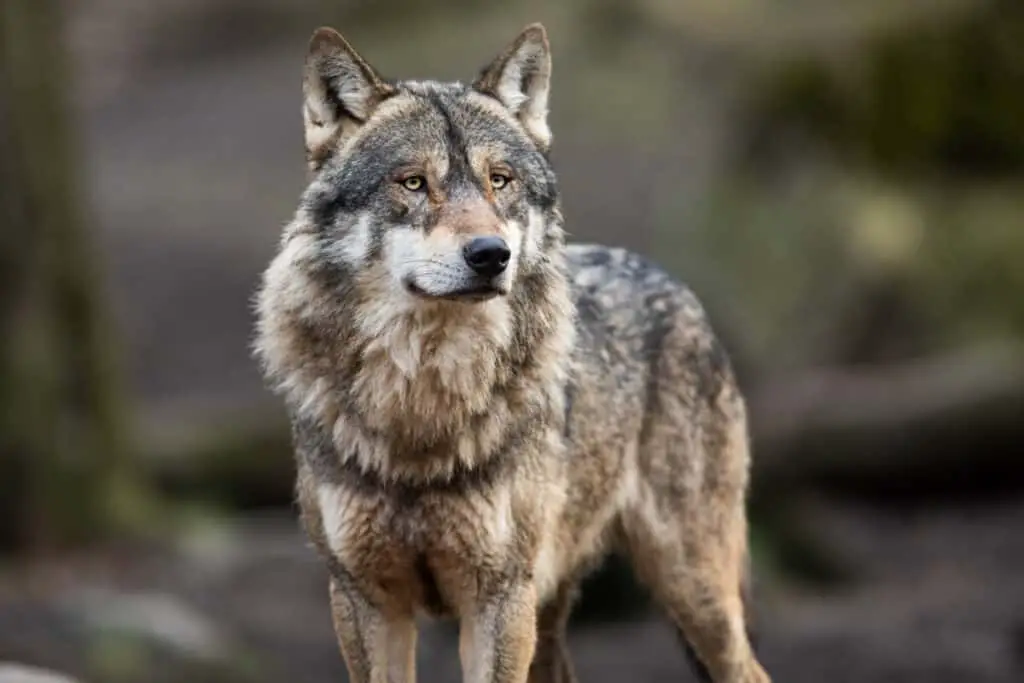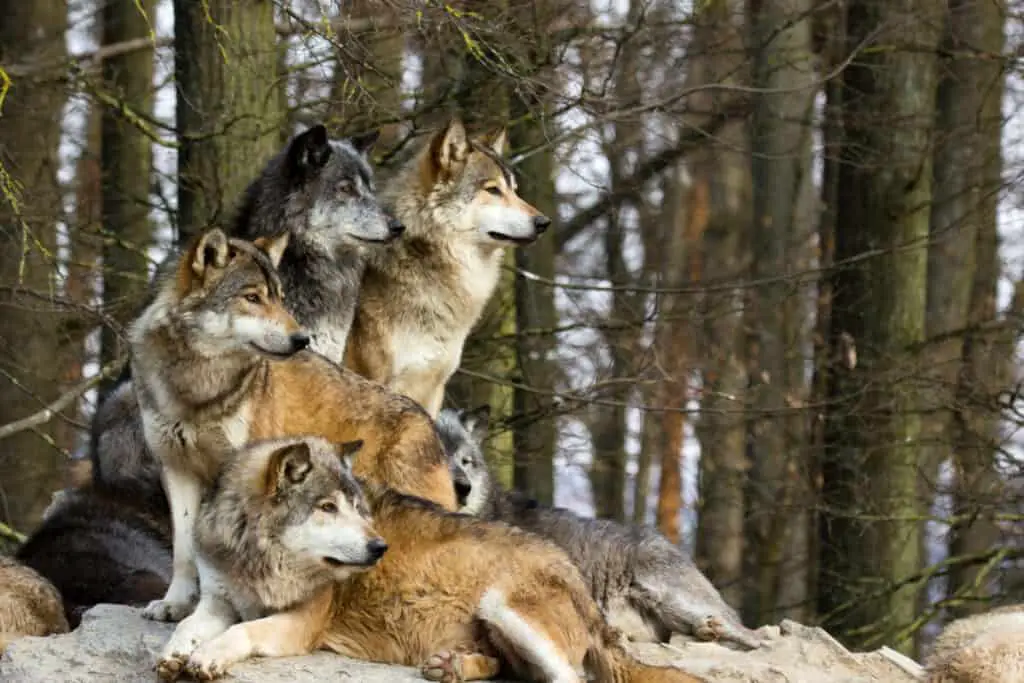Wolves are fascinating and iconic animals that has been revered in many cultures throughout history. With its sharp senses, powerful jaws, and fierce loyalty to its pack, the wolf has become a symbol of strength, wisdom, and resilience.
Despite their reputation as fearsome predators, wolves are actually highly social creatures that form tight-knit family units called packs.
These packs work together to hunt prey, raise offspring, and defend their territory against rival groups. While human activity has threatened the survival of many wolf populations around the world, these remarkable animals continue to inspire awe and admiration among those who appreciate their unique beauty and wildness.

The History And Cultural Significance Of Wolves
Did you know that in the United States alone, there were once an estimated 2 million wolves roaming free? Unfortunately, due to human intervention and hunting, their population has dwindled down to less than 6,000. This staggering statistic highlights just how much our relationship with wolves has changed over time.
Throughout history, wolves have been both revered and feared by humans. Many cultures have myths and legends surrounding these majestic creatures – from Norse mythology’s Fenrir to Native American folklore’s spirit wolf. These stories often depict wolves as powerful symbols of strength and wisdom.
However, as human civilization progressed and we began keeping livestock, wolves became seen as a threat to our livelihoods. This led to centuries of persecution through organized hunts and extermination campaigns. Despite this violent past, recent efforts have been made towards conservation and understanding the important role wolves play in maintaining ecosystem health.
| Species | Scientific Name | Distribution |
|---|---|---|
| Gray Wolf | Canis lupus | North America, Eurasia, Arctic |
| Arctic Wolf | Canis lupus arctos | Arctic regions of North America and Eurasia |
| Red Wolf | Canis lupus rufus | Southeastern United States (critically endangered) |
| Ethiopian Wolf | Canis simensis | Ethiopian Highlands (Ethiopia) |
| Indian Wolf | Canis lupus pallipes | Indian subcontinent (India, Pakistan) |
| Mexican Wolf | Canis lupus baileyi | Southwestern United States, Mexico |
| Eastern Wolf | Canis lycaon | Eastern Canada, northeastern United States (controversial) |
| Iberian Wolf | Canis lupus signatus | Iberian Peninsula (Portugal, Spain) |
| Himalayan Wolf | Canis lupus chanco | Central and South Asia (Himalayan region) |
| Italian Wolf | Canis lupus italicus | Italy |
Please note that the taxonomy and classification of wolves can be complex, and there may be regional variations and subspecies within these species.
Anatomy And Physical Characteristics Of Wolves
Now that we’ve explored the history and cultural significance of wolves, let’s dive into their anatomy and physical characteristics.
Wolves are a member of the Canidae family, which includes dogs, foxes, and coyotes. They have evolved over time to adapt to their environment, making them efficient predators.
One of the most notable evolutionary adaptations of wolves is their keen sense of smell. Their olfactory system is highly developed, allowing them to track prey from miles away. In addition to this skill, they also possess sharp teeth for tearing meat and powerful legs for chasing down prey.
When comparing wolf anatomy with other members of the Canidae family, it becomes apparent how these adaptations give wolves an advantage in hunting and survival.
Comparative Anatomy:
- Differences between wolf and dog skeletal structure
- Similarities between wolf and coyote dentition
- Adaptations present in both gray wolves and red foxes
As apex predators, wolves play a vital role in maintaining balance within ecosystems. Understanding their unique physical traits can help us appreciate their importance even more.
From their highly sensitive noses to their strong jaws, every aspect of a wolf’s anatomy has been carefully crafted through evolution to ensure its success as a predator in its environment.
These fascinating creatures continue to captivate our attention as we study them further and strive to protect them for generations to come.
Evolutionary Adaptations:
- The development of pack behavior in gray wolves
- How fur coloration aids in camouflage during hunting
- The impact human activity has had on wolf populations, leading to conservation efforts and reintroduction programs in some regions.
The Social Behavior Of Wolves
Some people believe that wolves are ruthless predators who only care about their own survival. However, this couldn’t be further from the truth when it comes to pack dynamics.
While dominance hierarchy does exist within wolf packs, it is not always a matter of aggression or violence towards other members. Wolves actually have a complex social structure with intricate communication and cooperation between individuals.
Dominance hierarchy is established through displays of body language and vocalizations rather than physical force. The alpha male and female are typically the leaders of the pack, but they must also maintain the respect and loyalty of their subordinates through fair treatment and protection.
This kind of cooperative behavior ensures the success and survival of the entire pack, making them one of nature’s most fascinating creatures.
Hunting And Feeding Habits Of Wolves
Wolves hunt in packs, which allows them to take down larger prey than they could on their own. They use a variety of hunting strategies depending on the type of prey they are after.
One common strategy is to chase the prey until it becomes exhausted. Another tactic is to surround the prey and attack from all sides. Wolves also have a preference for certain types of prey, such as deer, elk, and moose. However, they will eat smaller animals like rabbits and rodents if necessary.
Overall, wolves play an important role in maintaining ecological balance by controlling populations of herbivores and preventing overgrazing in ecosystems where they live.
When it comes to feeding habits, wolves are known for being opportunistic scavengers who will eat almost anything that’s available. This includes carrion left behind by other predators or even garbage from human settlements.
Despite this reputation, however, studies show that wolves primarily rely on fresh kills rather than scavenging for their meals. Their diet varies depending on factors such as location and seasonality but typically consists mainly of meat with some plant material mixed in as well.
In summary, while wolf feeding habits may seem indiscriminate at first glance, they actually exhibit a level of dietary complexity that reflects the diversity of their natural habitats.

Threats To Wolf Populations
Human wildlife conflict has been a major issue for many years now, as human encroachment into natural habitats continues to increase. Many wolves have lost their homes due to habitat destruction, leading them to move closer to human settlements in search of food.
Illegal hunting also poses a significant threat to wolf populations. Despite protective laws being put into place, some individuals continue to hunt wolves illegally for various reasons such as sport or revenge for livestock loss. This not only harms individual members of the population but can also lead to disruption in pack dynamics and ultimately harm the entire population.
It is crucial that we take steps towards reducing these threats so that wolf populations can thrive once again.
Ways you can help protect wolf populations:
- Support conservation organizations working towards protecting wolf habitats.
- Educate yourself and others on the importance of maintaining healthy predator-prey relationships.
- Report any illegal hunting activity you witness or suspect.
- Advocate for stronger protection laws for predators like wolves.
- Reduce your own impact on natural habitats by practicing sustainable living habits.
As humans, it is our responsibility to coexist peacefully with other species and ensure their survival. By taking action against human wildlife conflict and illegal hunting, we are doing our part in preserving not just wolf populations, but all forms of life on this planet. Let us work together towards creating a world where every creature thrives.
Conservation Efforts And Success Stories
Conservation efforts for wolf populations have been ongoing for decades, with success stories emerging from various regions around the world. Government policies and community involvement have played a significant role in these triumphs.
In North America, the gray wolf has made an impressive comeback after being listed as endangered under the Endangered Species Act (ESA) in 1978. Through government-led recovery programs and collaboration with local communities, the population of gray wolves has rebounded significantly. In fact, according to recent estimates by the U.S Fish and Wildlife Service, there are now over 6,000 gray wolves in the contiguous United States alone. This remarkable achievement is due in part to successful conservation measures that prioritize both ecological and social considerations.
Output using three paragraphs:
Conservation Efforts and Success Stories
Conservation efforts for wolf populations have been ongoing for decades, with success stories emerging from various regions around the world. Government policies and community involvement have played a significant role in these triumphs.
In North America, the gray wolf has made an impressive comeback after being listed as endangered under the Endangered Species Act (ESA) in 1978. Through government-led recovery programs and collaboration with local communities, the population of gray wolves has rebounded significantly. In fact, according to recent estimates by the U.S Fish and Wildlife Service, there are now over 6,000 gray wolves in the contiguous United States alone. This remarkable achievement is due in part to successful conservation measures that prioritize both ecological and social considerations.
Community involvement has also proved critical to saving wolf populations around the globe. For example, in Italy’s Apennine Mountains, locals worked together with biologists to reintroduce wolves into areas where they had previously been eradicated by human activity. These efforts were met with resistance at first but ultimately succeeded through education campaigns aimed at reducing fear of wolves and promoting coexistence between humans and wildlife. Today, the population of Apennine wolves is growing steadily, and their presence has even helped to boost ecotourism in the region.
Government policies have also played a vital role in preserving wolf populations. In India, for instance, the Indian government enacted strict laws prohibiting hunting or killing wolves under any circumstances. As a result, populations of both gray wolves and Indian wolves are now stable across much of the country. This success highlights how governmental action can make all the difference when it comes to conservation efforts.
| Wolf Species | Conservation Status | Estimated Population |
|---|---|---|
| Gray Wolf | Least Concern | 6,000 (U.S) |
| Mexican Wolf | Endangered | <200 |
| Red Wolf | Critically Endangered | <30 |
| Ethiopian Wolf | Endangered | ~5000 |
| Arctic Wolf | Least Concern | Unknown |
Without continued collaboration between governments, communities, and environmental organizations worldwide, these successes may not be possible in the future. By prioritizing conservation measures that take into account ecological as well as social factors such as community involvement and education campaigns, we can continue to ensure healthy ecosystems for generations to come.
Conclusion
In conclusion, wolves have a rich and complex history that has played a significant role in various cultures throughout the world.
Their physical characteristics are fascinating, from their sharp teeth to their keen sense of smell.
Wolves also exhibit intricate social behavior within their packs, which is truly remarkable to witness.
However, despite their majesty and importance in our ecosystem, wolves still face numerous threats such as habitat loss and hunting.
But with successful conservation efforts like reintroduction programs and public education campaigns, there is hope for these magnificent creatures to thrive once again.
So let us ask ourselves: will we continue to protect and preserve wolves for future generations to admire or allow them to disappear forever?

